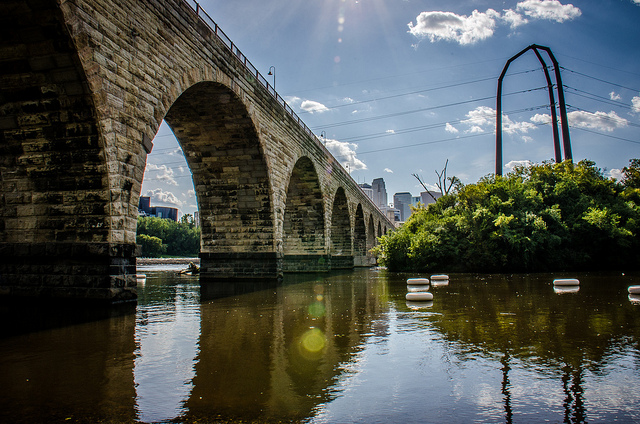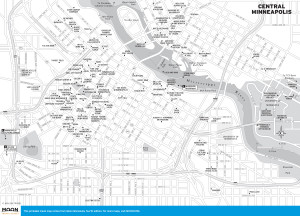
The iconic Stone Arch Bridge in Minneapolis. Photo © m01229, licensed Creative Commons Attribution.

Central Minneapolis
The Father of Waters has only one natural waterfall, St. Anthony Falls. The 50-foot drop was known as Minirara (Curling Water) to the Dakota, and Kakabikah (The Severed Rock) by the Ojibwe before Father Louis Hennepin honored his patron saint (Anthony of Padua) by bestowing it with the boring modern name. Hennepin was one of the first Europeans to see this spot when his Dakota captors led his exploration party past in 1680. Today a stroll through the old milling district is both a beautiful and educational experience.The closest you can get to the falls is at Water Power Park, on Hennepin Island. A bridge leads from Main Street, past the Xcel Energy Plant. Standing on the viewing platform, you can sometimes feel the spray from one of the best natural sources of waterpower in the nation. One of the country’s first hydroelectric plants was built here on Hennepin Island more than 120 years ago, and, to this day, Xcel Energy operates a plant on the island that powers downtown Minneapolis.
The 1.8-mile St. Anthony Falls Heritage Trail follows the riverfront past the falls, ruined mills, and other sights comprising this National Historic District, and numerous historical markers recount the fascinating natural, engineering, and industrial history along the way. A good place to begin the tour is on the east bank, at Old St. Anthony, where many of the renovated mid-19th-century buildings now house shops, restaurants, and watering holes—perfect for a bit of refreshment after you complete your loop.
Perched above Main Street is the small but tall Our Lady of Lourdes Church, the city’s oldest church still in continuous use. Originally built in the Greek temple style by the First Universalist Society in 1854, the Catholic French Canadian St. Anthony of Padua Parish purchased it 20 years later and added the bell tower and other features. To fund restoration projects, the parish office sells frozen tourtieres (meat pies).
Heading down Main Street you’ll pass the Pillsbury ’A’ Mill, a National Historic Landmark that was the world’s largest when built in 1881; it could turn out 5,000 bushels a day. It ground its last wheat in 2003 and is scheduled to become condos. Across from the mill is Father Hennepin Bluff Park. You can either walk alongside it or follow the steps down to the trails, bridges, and overlooks at the river’s edge.
Past the park, the trail crosses the river over the one-of-a-kind Stone Arch Bridge. Beginning in 1881, 600 men worked around the clock for 22 months to finish this vital link in James J. Hill’s railroad empire. Trains crossed the 23 granite and limestone arches for 101 years, but today bikers and pedestrians roll and stroll across the 2,100-foot span to take in the panoramic views it offers. The singular structure, built of 100,000 tons of stone, is now not only a Minneapolis icon, but a National Historic Civil Engineering Landmark.
The west end of the bridge passes the Upper St. Anthony Falls Lock and Dam, the last of the 29 locks along the Upper Mississippi River. The 56-foot lift accounts for 12 percent of the river’s total rise between here and St. Louis. Call to schedule a free group tour (877/552-1416, Apr.-Oct., times of tours are subject to availability) that discusses the engineering history, including details about the complicated process of shoring up the waterfall with its concrete apron, and the area’s unique geology.
The ancient-looking—if you ignore the steel beams and engine remnants—industrial ruins next to the lock are part of Mill Ruins Park (103 Portland Ave. S., 612/313-7793). Archaeological excavations will continue on the walls, canals, and tailraces for many more years. Call about tours and opportunities to assist in the digs.
Rising within the ruins of the Washburn-Crosby ’A’ Mill, also a National Historic Landmark, is the Mill City Museum (704 2nd St. S., 612/341-7555, 10am-5pm Tues.-Sat., noon-5pm Sun., $11 adults). The creatively constructed glass center has exhibits and performances about milling and associated topics such as railroads, agriculture, and waterpower. Guides lead riverfront walking tours (11am Sat. and 1pm Sun. June-Sept., $12). Perched above it all is an 8th-floor observation deck with superb views.
A block over, the longest cantilevered space in the country open to the public (178 feet) extends out from the Guthrie Theater (818 2nd St. S., 612/377-2224, 9am-1am daily) and offers another fantastic view. Ask at the ticket office about self-guided audio tours. Backstage tours (10am Fri.-Mon., $12 adults) last about 75 minutes.
Coming back across the Mississippi along the Hennepin Avenue Bridge, you will descend onto the 50-acre enigma that is Nicollet Island, home to the Nicollet Island Inn—a respected hotel and fancy restaurant—and a hidden neighborhood of 19th-century homes.
Excerpted from the Fourth Edition of Moon Minnesota.